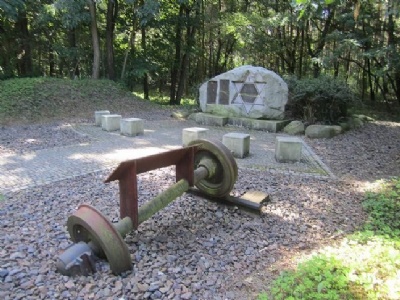Schipkau
Shortly before British forces liberated Bergen-Belsen, the SS evacuated about 6,700 Jews from the camp divided in three train transports. Most likely, the transports were destined for Theresienstadt in Bohemia-Moravia but no one knows for sure. These evacuations were not unique for Bergen-Belsen but occurred at all camps threatened by the enemy. In some camps, evacuation was carried out on foot, by truck or as in Belsen’s case by train. Common to them all was that the prisoners were usually sick or physically weak as a consequence of the hardship they had suffered in the camp, especially at the end of the war. The first transport departed on 6 april with about 2500 jews who after six days arrived at Farsleben, north of Magdeburg, where it was abandoned by the germans and liberated next day by american troops.
The second transport departed on April 9 with about 1700 prisoners arriving after twelve days to Theresienstadt where they were liberated by the Red Army. During that transport, a typhoid epidemic broke out and the transport was also accidentally bombed by allied aircraft. The last transport has gone down in history as ”the Lost train” (Verlorener Zug) and departed from Belsen on April 11. The transport consisted of about 2400 Jewish prisoners from twelve nations and it was liberated twelve days later by the Red Army in Tröbitz, about seventy kilometres south of Berlin. Then, like the first transport, it had also been abandoned by the guards. During transport, a typhoid epidemic erupted and about 200 prisoners did not survive, another 300 prisoners died in the days following the liberation. During the trip, the transport stopped at 21 places and between 19 – 20 April it stood just outside Schipkau, about thirty kilometres east of Tröbitz.
Current status: Monument (2012).
Location: 51° 31' 12.60" N 13° 54' 37.37" E
Get there: Car.
Follow up in books: Blatman, Daniel: The Death Marches: The Final Phase of Nazi Genocide (2010).

When the camps and prisoners were evacuated from various camps, there was in most cases a given destination for the transports. But whether or not they arrived at the original destination was not obvious, it usually depended on the military situation and the condition of the railway network. Railways were frequently bombed by the Allies to impede German troop transport and this had consequences for evacuation transports as well. The railway network was heavily congested and military transport had priority and evacuation transports were therefore forced to several stops where they had to wait up to several days before they could continue. Then they had to take the line that was currently available, even if it meant a completely different direction than the planned one. During these stops, it was highly unusual for the prisoners to be allowed to leave the train. At Schipkau and Tröbitz there are memorials for ”the Lost train” and at Schipkau there are 51 prisoners from the transport buried.